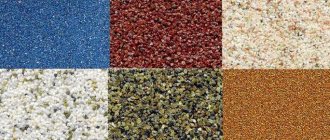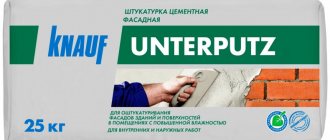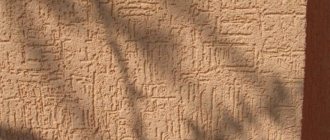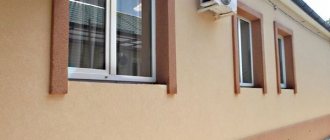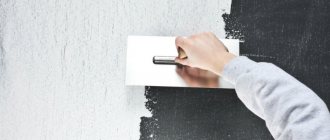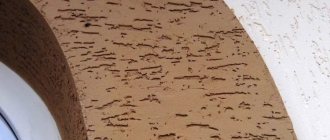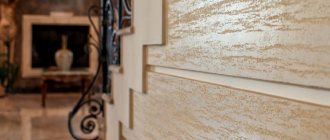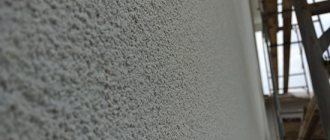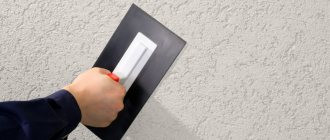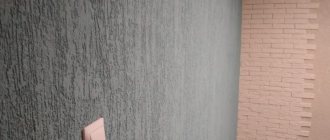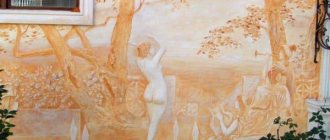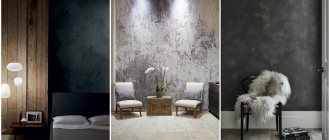An interesting, strong and durable material, bark beetle facade plaster is a suitable option for decorating facades. As well as an original element of interior decoration, which can be used in both home and office interiors, as well as private homes and restaurants.
Bark beetle plaster for interior work is also used very widely - in Russia and abroad.
Long lasting results.
This type of decorative plaster came to Russia from the West. And it caught on thanks to its durability and original appearance. Today in our country such coating can be found on the facades of many buildings - residential and public, private and multi-apartment.
Its popularity as a façade finish is explained by its special properties. Relatively low in price, ceresit plaster (bark beetle) can withstand mechanical loads well - it is difficult to damage it by hitting it with some object. It does not allow water to pass through or absorb it.
At the same time, it is vapor permeable, which allows the walls to “breathe”. In addition, bark beetle facade plaster, whose thermal conductivity is very low, serves as an excellent heat insulator. Bark beetle facade plaster is not afraid of fire, it does not burn. And when it is heated to high temperatures, substances harmful to human health will not be released.
Another advantage of bark beetle is that it is prepared from inert ingredients, and therefore is considered environmentally friendly. This allows it to be used in a variety of places.
In addition, external bark beetle plaster can last for a very long time. Atmospheric precipitation is not scary for her. Mold does not live on such a coating. And if you use mineral binders as a filler instead of quartz, you can significantly reduce weight. And thereby reducing the load on the load-bearing elements of buildings.
Grain in the decoration of the facade.
The bark beetle plaster on the wall looks as if diligent grinder bugs have walked through it. Bizarrely shaped “paths” create a pattern very similar to the one that covers sections of old trees.
The effect of a beetle-eaten wood surface of the façade is achieved using small stones - marble chips, minerals, acrylic dispersions, and the inclusion of titanium dioxide. The size of the “crumbs” varies from one tenth to three and a half millimeters. And it is the main determining factor in creating a particular texture of the finished surface.
In professional language, this factor is called “graininess”. And it directly affects the width and depth of the grooves on the coating. And this determines how the finished “product” will look as a whole. Plaster with fine grains is usually used for interior decoration. But coarse-grained options look great on facades. Types of bark beetle plaster differ from each other in other parameters.
Bayramix
A mixture from Bayramix is applied in a thicker layer. It is recommended for use when decorating facade insulation systems made using the “wet” type. Suitable for application to almost any surface. This can be concrete blocks, cement plaster, gypsum and plasterboard, all types of wooden surfaces. More often, such finishing is used in public buildings.
Bayramix Baytera (Bayramix Baytera) - Thick-layer plaster with mineral filler
Cost:
- 20 kg – 1890 rub.
Description:
- consumption – 2.5-4.0 kg/m2;
- drying time – 24 hours;
- grain size – 1.5-2.5 mm.
Pros:
- 16 colors;
- hides minor defects;
- High strength.
Minuses:
- No.
Bayramix Baytera
Price:
- 20 kg – 1890 rub.
Characteristics:
- consumption – 2.5-4.0 kg/m2;
- drying time – 24 hours;
- grain size – 0.25 cm.
Advantages:
- 16 colors;
- hides minor defects;
- High strength.
Flaws:
- No.
Bayramix Baytera
Price:
- 25 kg – 2570 rub.
Description:
- consumption – 2.0-3.0 kg/m2;
- drying time – 24 hours;
- grain size – 0.15 cm.
Pros:
- 16 colors;
- hides minor defects;
- High strength.
Minuses:
- No.
Types of material.
Based on its composition, bark beetle façade plaster is divided into four types:
- acrylic - produced in the form of a suspension using acrylic polymer; this plaster has good adhesion, so it performs well in a humid environment, which is why it is widely used where there is a lot of water, for example, in swimming pools;
- silicate: its main component is potassium silicate (another name is liquid glass); has high vapor permeability because it includes water-repellent additives; has a large palette of colors;
- silicone: due to its characteristics, bark beetle silicone plaster is not subject to cracking, resists moisture very well, and is more durable compared to other types; the most expensive of them;
- cement-lime: quartz crumbs are added to it; it tolerates low temperatures well.
Types of plaster
Types of bark beetle depending on the basis:
- Acrylic
Acrylic plaster is sold completely ready for use, and mineral plaster is sold in powder form. Marble shavings are added to the base. It gives special strength to the facing material. It is she who helps create beautiful design patterns on the facades of houses. Depending on what pattern you want to see, the size of the marble chips will vary from 0.8 to 3.5. Larger ones will create a deep furrow pattern and vice versa.
The approximate service life of plaster is 50 cycles, that is, about 25 years.
An important advantage of acrylic plaster is that you can add color to it and the wall will not need further painting. At the same time, the color is more susceptible to fading from ultraviolet radiation than paint applied on top of the facade.
- Mineral
The mineral base is the most stable. The cement is durable and easy to apply. Perhaps the best option in terms of price and quality.
- Silicone
Silicone plaster is made from natural silicone resins. Its price is higher and it is quite problematic to find real material
- Silicate
Such bases are made from liquid glass. The highest quality foundations: they are strong, breathable and very durable. They are also the most expensive in their segment.
Outside and inside.
On the modern market, bark beetle wall plaster is offered in three main versions. Options for bark beetle plaster for interior and exterior decoration:
- for interior spaces;
- for use on building facades;
- for use both inside and outside – it is a universal material.
Bark beetle facade plaster is sold ready-made - in the form of a solution, already with added dye. Take it and do it. This is, of course, very convenient. But such plaster is quite expensive. There are dry mixes that are sold in bags. Dry bark beetle plaster is white in color. However, the colors of bark beetle plaster can be any color. You can give the desired shade using color.
Since the structure is quite dense, it will be difficult to manually mix it with paint. This is done using special machines. The appropriate color is selected in a special computer program. With the right approach, diluting the consistency correctly will not be difficult. And the price will be significantly lower than when using a ready-made suspension. Today, many options are offered: “Starateli” bark beetle plaster, “Bergauf” bark beetle plaster, “Diamant” bark beetle plaster and others.
Manufacturers
The best-selling brands are: “Ceresit”, “Dufat”, “Baumit”. Durability, quality, and aesthetics of the surface determine their advantage when chosen by the buyer.
German investment projects underlie the recognition of domestic Bolars in the construction market, which supply more than 20 regions of Russia and the CIS countries with their products. The products of these brands comply with the State Standard of the Russian Federation and international technical requirements.
In addition to them, decorative bark beetle plaster is produced by Russian companies, Vetonit, Atlas, Volma, Hercules, Kaparol.
The group is the successor to the leading enterprises of Soviet industry producing hundreds of product ranges of dry mixtures. UNIS has hygiene certificates, which allows it to make supplies for the construction of children's and medical institutions.
Despite the large number of domestic manufacturers, it is still better to give preference to foreign brands.
Flight of fancy.
Facade bark beetle plaster and this type of interior finishing material have one interesting feature. The coating obtained with this solution is original every time.
A real space for creativity. Patterns can resemble flowing droplets of water, tree bark, circles and so on.
This or that effect is created by a special tool - a trowel, made of steel or plastic. The configuration and arrangement of its teeth gives a variety of shapes on the plaster layer. And different colors of façade bark beetle plaster further expand the design possibilities.
Material basis.
Can be applied to different surfaces. And this is also its undeniable advantage over some other options for facade or interior decoration. Bark beetle plaster works well on concrete, plasterboard, brick, and polystyrene boards. It can be used to finish sandwich panels.
But it is better not to use it for metal, plastic, smooth glass and wood. It won't last. In order to lay flat and last as long as possible, you should first cover the base with a base - plaster prepared using cement or gypsum.
The point is that this is the final stage. Therefore, it is not worth covering up various depressions and cracks with it - appropriate materials are suitable for this.
Preparing the mixture
Construction mixtures are prepared according to the instructions. They are diluted with water, which is preheated to 20 degrees.
Figure 3. Ready-made building mixture.
How to properly mix the decorative mixture?
To avoid the appearance of lumps, stir the plaster with a construction drill. Immediately after preparing the solution, it is applied to the wall.
Bark beetle mixture consumption
During finishing work, the material is simultaneously applied to the entire wall, so the mixture is calculated first. On average, 3 kilograms of material are used per 1 square meter. This figure is multiplied by the area of the wall.
Methods for staining bark beetles
Several methods of staining bark beetle . You can add color to the mixture, which will ensure color stability. If the plaster is not pre-tinted, then it is painted with paint after drying.
Color and appearance of plaster
The façade finishing technology involves using a variety of colors. The original option is deep painting of the base with all the cracks and depressions, rather than surface painting of the walls. You can finish decorative panels that use a dark color. The wall itself is painted in a lighter shade.
Economical consumption.
The optimal layer is about three millimeters. If you work with dry bark beetle plaster, the consumption per 1 m² will average 2.5 - 3 kilograms. More accurate numbers and price per sq. m can be calculated by following the recommendations on the packaging: each type of bark beetle plaster has its own parameters. Consumption depends on the size of the grain - crumbs. So, with a grain size of three and a half millimeters, more material will be required. If the crumb size is 2.5 millimeters, less.
Experts advise adding another five to ten percent per m² to the resulting figure - as a reserve. Bark beetle plaster, the consumption of which is determined correctly, will allow you to quickly cope with the task. The price of a bag of dry mixture weighing twenty-five kilos will result in six hundred to three thousand three hundred rubles. The cost of applying it is about 500-800 rubles per square meter.
You can order the product for delivery or buy it in person in the store. Thus, bark beetle plaster, the consumption of which may vary per 1 m², will be an excellent solution for decoration - inside and outside the building.
For interior work
Less stringent requirements apply to bark beetles for interior work. The main condition is the ability of the surface to be decorated to adhere. The plaster will not adhere to smooth metal or glass materials. The advantage of this type of decoration for interior walls is the ability to create a wide variety of patterns. Thanks to this, you can decorate the interior in any design option.
Bark beetle decor UNIS
Price:
- 25 kg – 370 rub.
Description:
- vapor permeability – 0.1 mg/mchPa;
- drying time – 2-3 days;
- consumption at a thickness of 2 mm – 3.5-4.5 kg/m2;
- grain size – no more than 2 mm;
- White color;
- shelf life – 12 months.
Advantages:
- “breathable” coating;
- does not scratch;
- can be painted multiple times.
Flaw:
- No.
Knauf Diamant Bark beetle grain 1.5 mm
Cost:
- 25 kg – 370 rub.
Description:
- vapor permeability coefficient – 0.1 mg/mchPa;
- consumption – 2.5 kg/m2;
- grain size – 1.5 mm;
- color scheme – white;
- operating temperature – from -50 to +65 degrees;
- shelf life – 12 months.
Advantages:
- variety of design;
- protection and increased strength;
- Possibility of machine application.
Flaw:
- high consumption.
Nuances of technology.
There are no particular difficulties when using bark beetle. Instructions for use are detailed on the packaging. Additionally, it is worth considering some points. For example, temperature conditions. Plaster is applied under the bark beetle when the outside air has a temperature in the range from plus five to plus thirty degrees Celsius.
In this case, humidity should not exceed eighty percent. In this regard, the autumn or spring season is best suited for plastering work.
Another important point is that after diluting the composition, it must be quickly used in its entirety. Otherwise, if you work slowly, the solution will harden: it has the ability to set quickly.
It is also important that when diluting the mixture to cover one surface, water with the same characteristics is used. The color also needs to be taken from the same batch. Then the textured bark beetle plaster will look perfect.
Finishing layer.
The finished coating can be painted. Silicate or silicone paint is suitable. Experts recommend painting not immediately after applying the plaster. At least three days must pass. In the instructions you can read that the bark beetle dries completely in twenty-eight days. Paint for bark beetle plaster is applied with a brush, fur roller or spray gun. Painting bark beetle plaster makes the surface stronger, it looks longer as if it had just been formed.
Pleasant neighborhood.
Textured bark beetle plaster looks good next to other materials. A harmonious combination can be achieved by combining plaster with artificial stone, ceramic tiles and vinyl wallpaper. You just need to decide what the “picture” you intend to get will look like. Determine the ratio of its elements made of different materials. You can do this yourself by studying the recommendations of specialists. Or you can turn to experienced designers.
Bark beetle, which is good for the home
The traces left by the wood-boring beetle are intertwined into an incredible pattern that could easily bewitch, if not for the damage caused by this inhabitant of dry trunks and wooden buildings. However, now it is possible to give the walls this attractive and unusual pattern without any harm to them.
This can be done using bark beetle plaster, which will be discussed in this article. It is possible to obtain an interesting texture thanks to small stones (grains) of various sizes specially added to the mixture.
With my own hands.
Is it possible to do the job yourself using a bark beetle? Certainly! A little effort, strict adherence to the instructions, the correct consumption of bark beetle plaster per 1 square meter, a little experience in repair work - and you will succeed.
For creativity you will need simple tools:
- spatulas of different sizes and shapes;
- dilution container;
- plastic grater;
- drill with a mixer attachment.
First, the surface to be finished is prepared. All dust, grease, mold, oil stains and dirt must be removed from it. Then all irregularities are filled with putty. It is allowed to leave depressions or bulges, the size of which is not larger than the size of the grain. There should be a level field for further work.
After the putty has dried, it is coated with a special primer - primer paint. It is important that its shade matches the tone of the plaster itself. Then there will definitely not be a situation where the soil shows through the coating layer. Moreover, when finishing the facade, according to some experts, it is not necessary to use primer. Once the primer is completely dry, which usually takes four to six hours, you can begin applying.
It is better to apply with a steel spatula. In this case, the adjacent walls, if they are not finished, should be protected - stick masking tape near the corners or cover the entire plane with a protective film.
It is important to apply it so that its layer is uniform over the entire surface. The technology is very similar to conventional putty. You need to continue “rubbing” until the grooves become noticeable on it.
After this, a drawing is formed. It is made with a plastic grater. Experts advise holding it at an angle of sixty degrees relative to the wall surface. You need to “rub” until the particles stop sticking to the grater. You don't need to put in much effort. First, they go over the entire layer with a trowel, then, when the plaster dries out a little, they do it again, completely. It is important to ensure that the pattern is uniform.
How to apply
The key factor is preparation of the base. It is leveled and primed using the composition specified by the plaster manufacturer in the instructions. After that:
- Distribute the solution using a spatula, remembering that the thickness of the applied layer cannot be less than the maximum size of the fractions present in the mixture.
- Pause for 5 - 10 minutes (depending on the parameters of the plaster) so that the outer layer sets. It shouldn't stick to your hand.
- Using a plastic grater, form a pattern. Due to the movement of solid particles present in the solution, characteristic grooves are formed on the surface. Their direction depends on the direction of movement of the grater.
Any minor defects found can be removed using coarse sandpaper. If this cannot be done, it is recommended to completely remove the applied layer of material and apply a new one. It is forbidden to increase the layer thickness beyond the permissible limit in order to level out unevenness! This may cause the plaster to peel off.
